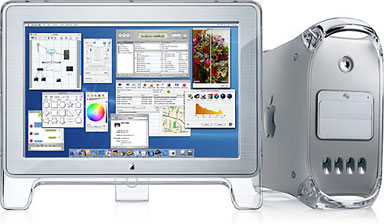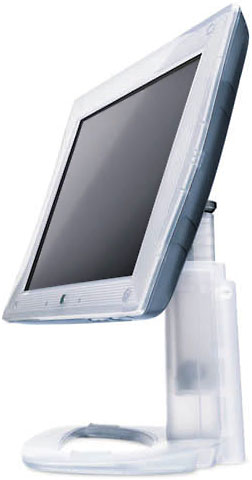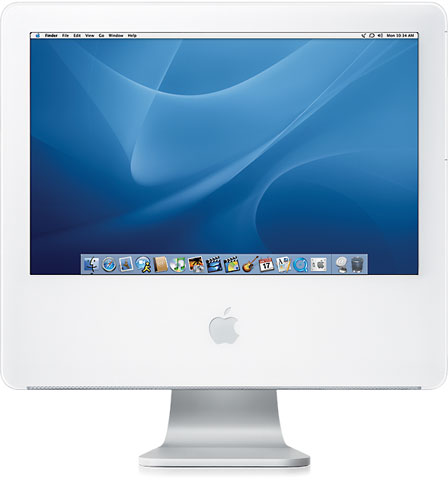2000 – Getting a good rumor from Apple is harder than pulling teeth these days. The Jobs regime may have made the Apple campus more secure than the CIA.

Of course, that doesn’t stop the leaks, let alone speculation. After all, Macworld New York is coming in mid-July. There has to be some new hardware.
The predictable: Faster Macs based on IBM’s new PowerPC 750CX and 750CXe processors, which draw less power, run at higher MHz speeds (up to 700 MHz!), and have an internal 256 KB Level 2 cache to really boost performance.
Also predictable: Faster Power Macs based on as fast a G4 CPU as Motorola and IBM can ship.
 But there will be surprises. In the Wintel world, more computers sell with 17″ screens than 15″ ones. Expect Apple to address that with a next generation computer that may or may not be the oft-rumored 17″ iMac. Our best guess is a very small computer with iMac insides but no display; users will be able to connect any sized monitor or one of Apple’s Cinema Displays.*
But there will be surprises. In the Wintel world, more computers sell with 17″ screens than 15″ ones. Expect Apple to address that with a next generation computer that may or may not be the oft-rumored 17″ iMac. Our best guess is a very small computer with iMac insides but no display; users will be able to connect any sized monitor or one of Apple’s Cinema Displays.*
You read that right – plural. The rumor sites are absolutely right about the 18″ Cinema Display, dubbed CineMini by insiders. The flat panel display will share the 1600 x 1024 output of the current 22″ Cinema Display, but with a smaller footprint, lower weight, and far more attractive price.
This is what comes of Apple’s investment in Samsung’s LCD production facility.
Better yet, the 18″ panel will form the basis for not just one product, but three.
18″ Cinema Display

Apple’s huge 22″ Cinema Display
The first is the commonly rumored 18″ Cinema Display. But it will one-up the old 22″ display in several respects. First, it will act as a powered USB and FireWire hub with two ports for each. Second, it will have enough intelligence to show live video from a camcorder via either FireWire or S-video input.

15″ Studio Display
Third, it will swivel like Apple’s 15″ Flat Panel Studio Display. For those who prefer a vertical perspective on things, turning the screen 90° counterclockwise an making it into a 1024 x 1600 portrait display.
Expect a very attractive sub-$2,000 price tag.
The CineBook
Our last column about a PowerBook Cinema missed the mark in one respect: We believed it would be based on the 22″ Cinema Display. The prototype shown at the WWDC did use the larger display, but Apple determined it made the computer too large and heavy, not to mention too expensive.
It’s still going to be large, just not as large. It will be just under 19″ wide, 13.5″ deep, and somewhere around 2″ thick. Weight will be in the 10-12 pound range. Part of the reason for this is the third battery mentioned in our previous article.
Thanks to the smaller display and the new PowerPC 750CXe (G3+) processors, each battery will provide 3.5-4 hours of use, so a three-battery configuration will last for 10.5-12 hours in the field. Of course, you do have to remove one of the batteries for a DVD or CD-RW drive. (Rumors that the CineBook will support two CD or DVD drives proved correct!)
Price should still be stratospheric, probably starting $4,499 for a CineBook 500 with one DVD drive and one battery, and reaching $5,999 for the CineBook 600 with one DVD, one CD-RW, and two batteries. Build-to-order configurations will be available.
The CineMac

iMac G5, August 2004, included an IR remote control.
Part Cinema Display, part iMac, part iBook, the CineMac can sit on your desk, hang on the wall, or survive a trip in your backpack.
Behind the 18″ flat panel display beats the heart of an iMac DV, but based on a 600 MHz G3+. The slot loading drive is vertical and located on the right. Speakers are located at the bottom right and left corners – and it will work with iSub.
There’s an infrared receiver on the front for use with a new IR mouse, keyboard, game controller, and remote control. A TV card is a standard feature; with the IR remote you can watch DVDs, listen to CDs, or watch television. (The TV card and IR remote are options for the 18″ Cinema Display.)
The sides of the CineMac are rubberized, just like the iBook, so you’re less likely to drop it. Apple will provide a clear Plexiglas® cover to protect the screen and DVD drive during transit.
The CineMac is nestled in a base that supports it on the right and left, just over halfway up the sides. This allows the user to tilt the screen to eliminate glare.
The CineMac will also have a unique feature among desktop computers – at least we’ve never heard of it before. It will have a bay for a PowerBook battery, allowing the user to put the CineMac to sleep and transport it. The battery will also power the CineMac for a couple hours in the event of a power failure.
All this comes at a price, but not an unreasonable one. With the iMac DV SE selling for $1,499, the iBook SE for $1,799, and the CineMini expected at about $1,999, all the functionality in one unit for $2,999 could be a huge hit.
Apple is certainly learning how to target users with disposable income.
– Anne Onymus
- The Mac mini didn’t arrive until January 2005. It pretty much meets the description in this article.

